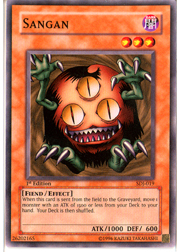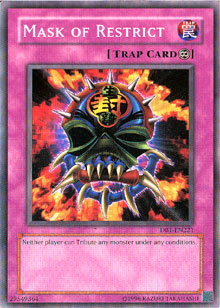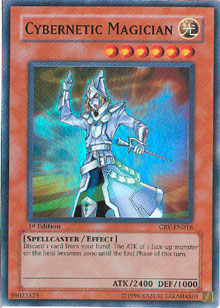“‘Time’ and ‘space’ are mere formalities to a Spellcaster.”
When the Spellcaster’s Judgment Structure Deck was released, some cards gained immediate popularity, but chief among them was Magical Dimension, which allowed Spellcaster-based decks to step up to a new level of play. It was only natural that players interested in Spellcaster-type monsters would give the card a good run . . . and eventually encounter situations in which they didn’t know how it worked.
This week, we’ll break apart Magical Dimension and cover its various rulings.
Welcome to the Magical Dimension
The text for Magical Dimension says: “You can only activate this card while there is a face-up Spellcaster-Type monster(s) on your side of the field. Tribute 1 monster on your side of the field and Special Summon 1 Spellcaster-Type monster from your hand. Then you can destroy 1 monster on the field.”
Magical Dimension has two limitations that you’ll need to keep in mind if you plan on putting it in your deck. In order to activate Magical Dimension, you must meet both of the following requirements:
- You must have a Spellcaster-type monster on your side of the field.
- You must have a Spellcaster-type monster in your hand.
Magical Dimension doesn’t have an activation cost. If you can meet the requirements of the card, you are free to activate it. Your opponent then has a chance to respond without knowing what monster you will tribute or what monster you will summon. Every act performed by Magical Dimension occurs when it’s resolved, so nothing is announced beyond the activation of the card.
 When you resolve Magical Dimension, choose a monster on your side of the field and tribute it. The monster you tribute doesn’t have to be a Spellcaster-type monster, so it’s perfectly fine to tribute a monster like Sangan or Treeborn Frog. You could even tribute a monster token if you like, including Sheep tokens. After you tribute a monster, choose a Spellcaster-type monster from your hand and then special summon it to your side of the field.
When you resolve Magical Dimension, choose a monster on your side of the field and tribute it. The monster you tribute doesn’t have to be a Spellcaster-type monster, so it’s perfectly fine to tribute a monster like Sangan or Treeborn Frog. You could even tribute a monster token if you like, including Sheep tokens. After you tribute a monster, choose a Spellcaster-type monster from your hand and then special summon it to your side of the field.
Now that you’ve special summoned your Spellcaster-type monster, you’re faced with a choice. Magical Dimension now allows you to destroy one monster on the field. You can choose a monster your opponent controls, or a monster that you control. Either way is perfectly fine.
The Sequence
Now that we’ve established its basic operation, let’s look at Magical Dimension’s complications.
The effects of Magical Dimension operate in a sequence, in which each effect depends on the previous event occurring successfully. If you don’t tribute a monster, you don’t special summon a Spellcaster. If you don’t special summon a Spellcaster, you can’t destroy a monster on the field. It isn’t possible to use Magical Dimension to destroy a monster if you couldn’t accomplish both of the first two effects in the sequence.
With this in mind, let’s examine what factors can influence the success of Magical Dimension’s effects in the sequence.
The first step in resolving Magical Dimension requires you to tribute a monster you control. The monster does not have to be a Spellcaster-type monster. As long as you have at least one monster on your side of the field, you’ll be fine, though there are a few exceptions to this rule.
Any monster that’s unaffected by the effects of spell cards (the “spell immune” monsters) cannot be tributed for Magical Dimension. This is because the tribute for Magical Dimension is part of the card’s effect and isn’t a cost. This will be a problem if you have no other monster you could tribute for Magical Dimension, because it will prevent you from completing the remainder of the card’s effect.
 Mask of Restrict can also be a problem at this point. Since you don’t tribute a monster when you activate Magical Dimension, it’s possible that your opponent could activate Mask of Restrict in a chain. When the chain resolves, you would be unable to tribute a monster, which would prevent you from carrying out the effects of Magical Dimension.
Mask of Restrict can also be a problem at this point. Since you don’t tribute a monster when you activate Magical Dimension, it’s possible that your opponent could activate Mask of Restrict in a chain. When the chain resolves, you would be unable to tribute a monster, which would prevent you from carrying out the effects of Magical Dimension.
The second step in resolving Magical Dimension is to special summon a Spellcaster-type monster from your hand. Most monsters of this type may be special summoned by this effect, unless it has restrictions that prevent you from doing so. Ritual monsters and monsters like Sorcerer of Dark Magic are off limits to Magical Dimension, but high-level monsters like Dark Magician are not.
Now we come to the final step: the option to destroy one monster on the field. At this point, you must decide if you want to destroy a monster, and if so, which monster you’ll destroy.
Naturally, players will want to know if this effect targets. The answer is no. Why? Because the destruction of one monster on the field is entirely optional. When you activate the card, your opponent has no idea if you’ll destroy a monster, and he or she also has no idea what monster it would be. Knowing this, when you activate Magical Dimension, your opponent will have to respond without knowing exactly what you plan to do. This uncertainty can actually prevent some cards from being used in response. For example, the spell card My Body as a Shield cannot be used to stop Magical Dimension, because the destruction of one monster is entirely optional.
Points of Conflict
Some important timing issues come into play with the optional monster destruction effect. Whether or not the player chooses to use this portion of Magical Dimension’s effect can alter the possible responses once the chain has finished resolving.
With cards like Torrential Tribute and Bottomless Trap Hole, if the last action of a chain’s resolution is the summoning of a monster, it’s possible to activate either card as part of a new chain. This can occur with Magical Dimension, but only if the player who activated it decides not to use its monster-destroying effect. Otherwise, it changes what the last action is and removes the proper timing that Torrential Tribute and Bottomless Trap Hole are looking for.
Example 1: Cybernetic Destruction
 Selene activates Magical Dimension. Her opponent, Donald, has no response, and the chain is allowed to resolve. Selene tributes a monster and special summons Cybernetic Magician. Her opponent doesn’t have any monsters, so she decides to not use the monster-destroying effect. At this point, the chain has finished resolving and the last action was the special summon of her Spellcaster-type monster, so the timing is right for Donald to activate his set Bottomless Trap Hole.
Selene activates Magical Dimension. Her opponent, Donald, has no response, and the chain is allowed to resolve. Selene tributes a monster and special summons Cybernetic Magician. Her opponent doesn’t have any monsters, so she decides to not use the monster-destroying effect. At this point, the chain has finished resolving and the last action was the special summon of her Spellcaster-type monster, so the timing is right for Donald to activate his set Bottomless Trap Hole.
Example 2: Cybernetic Victory
Selene may have lost her first Cybernetic Magician, but it hasn’t daunted her efforts. Later in the duel, she activates another Magical Dimension, to which Donald has no response. Once again, she tributes a monster and special summons Cybernetic Magician, only this time she decides to use the monster-destroying effect to destroy Donald’s only monster. At this point, the effect has finished resolving, and so has the chain. The last action in this chain was the destruction of Donald’s monster, and not the special summon of Cybernetic Magician. Therefore, Donald isn’t able to activate his set Torrential Tribute.
The resolution of Magical Dimension also has an impact on one special Spellcaster-type monster, and that’s Dark Magician of Chaos. In order to use its effect when it’s special summoned, the special summon must be the last action of the chain. If you special summon Dark Magician of Chaos and then choose to use the monster-destroying effect of Magical Dimension, when the chain has finished resolving, the timing window for Dark Magician of Chaos will have passed, preventing you from using its effect to retrieve a spell card. You will need to decide which of the two effects is more important when the time arrives. You can’t get both.